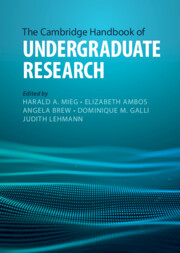Book contents
- The Cambridge Handbook of Undergraduate Research
- The Cambridge Handbook of Undergraduate Research
- Copyright page
- Contents
- Figures
- Tables
- Contributors
- Foreword
- Foreword
- 1 Introduction
- Part I Theory and Research on Undergraduate Research
- Part II Implementation, Approaches, Methods
- Part III Disciplines
- 17 Introduction
- Part III.1 STEM
- Part III.2 Health
- Part III.3 Social Sciences
- 28 Undergraduate Research in Sociology
- 29 Undergraduate Research in Psychology
- 30 Undergraduate Research in Economics
- 31 Undergraduate Research in Political Science
- Part III.4 Humanities
- Part III.5 Arts & Design
- Part III.6 Disciplines A–Z
- Part IV International Perspective
- Part V Avenues for Developing Undergraduate Research
- Index
- References
31 - Undergraduate Research in Political Science
from Part III.3 - Social Sciences
Published online by Cambridge University Press: 11 August 2022
- The Cambridge Handbook of Undergraduate Research
- The Cambridge Handbook of Undergraduate Research
- Copyright page
- Contents
- Figures
- Tables
- Contributors
- Foreword
- Foreword
- 1 Introduction
- Part I Theory and Research on Undergraduate Research
- Part II Implementation, Approaches, Methods
- Part III Disciplines
- 17 Introduction
- Part III.1 STEM
- Part III.2 Health
- Part III.3 Social Sciences
- 28 Undergraduate Research in Sociology
- 29 Undergraduate Research in Psychology
- 30 Undergraduate Research in Economics
- 31 Undergraduate Research in Political Science
- Part III.4 Humanities
- Part III.5 Arts & Design
- Part III.6 Disciplines A–Z
- Part IV International Perspective
- Part V Avenues for Developing Undergraduate Research
- Index
- References
Summary
Political science (PSCI) is housed in the social sciences, which together “examine what it means to be a social being, ranging from the minutiae of human behavior … to large scale social movements, demographics, economics and politics” (European Science Foundation, 2016). Undergraduate research (UR) in PSCI, whether using quantitative, qualitative or mixed methods, helps students develop critical thinking skills and tools, whereby they can apply what they learn in class to the real world, rather than just memorizing facts and figures that are forgotten after they take each semester exam.
Keywords
- Type
- Chapter
- Information
- The Cambridge Handbook of Undergraduate Research , pp. 303 - 310Publisher: Cambridge University PressPrint publication year: 2022



